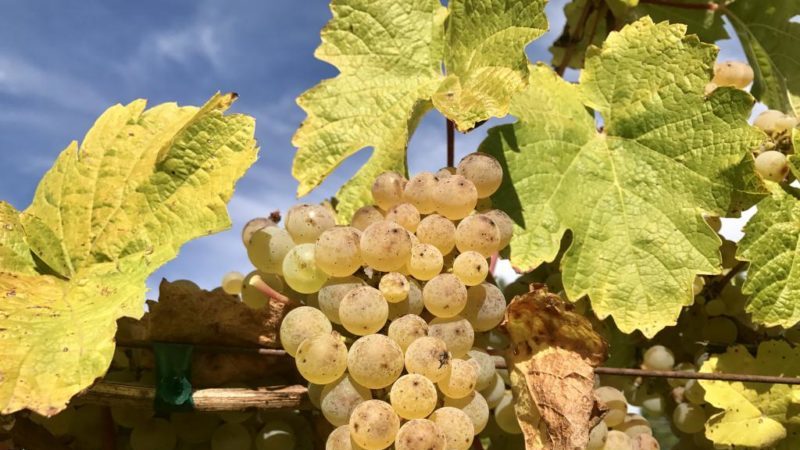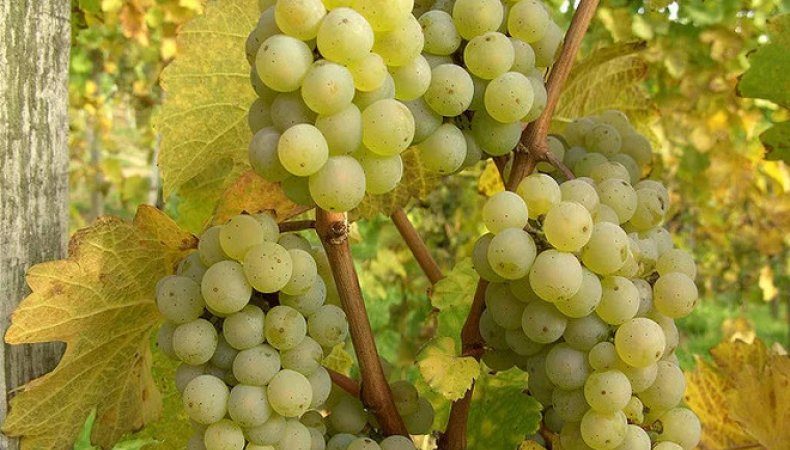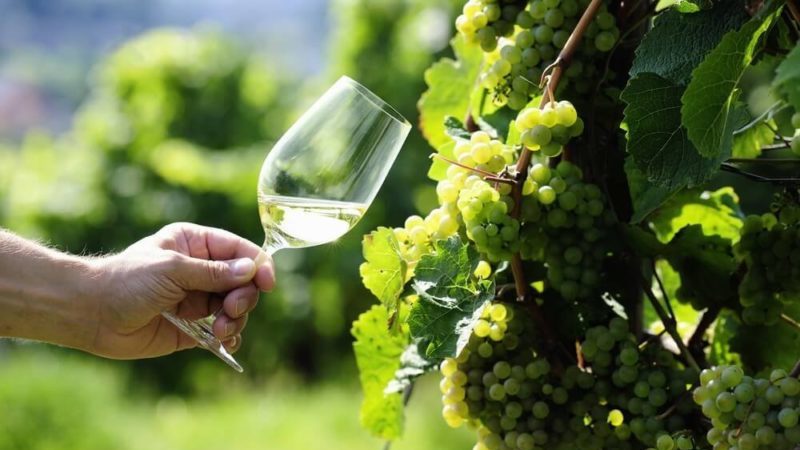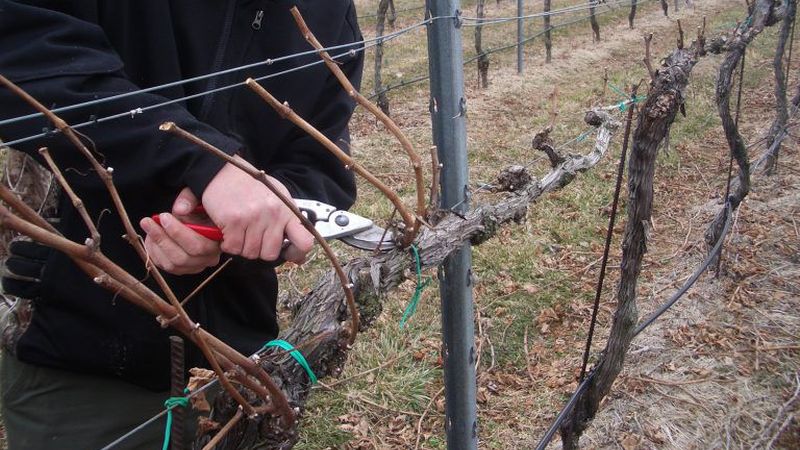A very popular and delicious grape variety "Riesling"
The Riesling grape variety has received worldwide recognition. In Germany, this culture is called the queen of white grapes. Wine made from Riesling grapes is characterized by lightness, harmony and refinement. The bouquet contains floral, herbaceous and fruity notes. After three years of aging, oil notes appear in the drink - a characteristic feature that distinguishes Riesling from other white grape wines. The article will tell you about the features of the variety, planting technology and cultivation Riesling grapes.
The content of the article
Description and characteristics of the Riesling grape variety
Riesling (German Riesling) is a technical white grape variety originally from Germany. Other names: White Riesling, Rhine Riesling, Johannisberger, Riesling Johannisberg. It is important not to confuse the original variety with the clones: Gray Riesling (California), Emerald Riesling (California), Missouri Riesling (Missouri), Italian Riesling (Italy).
The grape displays the characteristics of the terroir, retains the varietal individuality, the wine made from it can “live” for a long time in the cellar. Thanks to these characteristics, Riesling has earned the reputation of the greatest variety for the production of white wine.

Origin story
Classification of varieties in German winemaking is not an easy topic. Around 60 Riesling clones are allowed to be cultivated in the country. Riesling's reputation is spoiled by the varieties that are parasitic on his name, giving, though not bad, but often indistinct wines that have nothing to do with the original grapes.
The exact time of the appearance of the variety on German soil has not yet been established. Winegrowers rely on a centuries-old tradition of cultivating the variety - the first written mention dates back to 1430. The culture is cultivated in a way that is not done in any other wine-making country.
Interesting. The results of DNA research showed that Riesling appeared as a result of cross-pollination of the Gue blanc variety and the Traminer hybrid with wild grapes.
In Germany, two thirds of all vineyards are Riesling. The variety is grown for the longest time in the Rheingau and on the Moselle river. Here the variety occupies more than three quarters of the territory. The Moselle-Saar-Ruver, Nahe Württemberg, Palatinate, Rheingessen and Baden are also considered the most important wine regions in the country.
Riesling ripens slowly, fruiting lasts until November. The German climate is best suited for its cultivation. Here he can catch the last warm rays of the sun and receive the optimal amount of moisture. Vineyards are located on steep rocky levels along rivers, thereby providing maximum sun heating.
Description of vines of grapes, bunches and fruits
Riesling belongs to the ecological-geographical group of Western European varieties by morphological characteristics and biological characteristics.... The culture is widespread in the USA, Germany, Switzerland, Bulgaria, Austria, Hungary, Czech Republic, Romania, Argentina.
The bushes are characterized by great vigor, the vine ripens completely. Young shoots are sparsely covered with light green felt-type pubescence with pink teeth. A ripe annual shoot acquires a light brown tint, darker at the nodes.
Leaves are medium in size, rounded, medium and deeply dissected, three- and five-lobed, large-walled type, folded-funnel-shaped. The upper notches are closed, of medium depth, with an oval lumen. There are also open, lyre-shaped leaves. In autumn, the leaves turn yellow.
The petiole notch is closed or open, lyre-shaped, with a narrow elliptical lumen. The teeth are triangular. The marginal denticles are dome-shaped. The leaf plate is covered with a cobweb edge on the back side, on the veins there are small bristles.
The flowers are bisexual, but this does not save the variety from peas. A bunch of medium size, dense and loose, 8-14 cm long, 6-8 cm wide. The shape is usually cylindrical, less often cylindrical-conical. The stem of the bunch is short - only 3 cm.The average weight is 80-100 g.
Berries of medium size - 11-15 mm, round, green-white with a yellow tinge. The skin is thin but firm and covered with dark brown spots. The pulp is juicy, contains 2-4 seeds. The taste is pleasant, balanced. Average weight - 1.2-1.4 g.
The sugar content of the berries is 18-21%, the acidity is 8.5-10.5 g / l. Grape juice yield - 80%. The calorie content of berries is 43 kcal per 100 g.

Yield
The yield is low, depending on the climate and place of cultivation. The average is 70-90 c / ha. The fruitfulness of the shoots is 87%. On average, there are 1.6 clusters per one developed shoot, and 2 clusters per fruitful one.
Frost and drought resistance
The variety is characterized by resistance to frost down to -20 ° С, firmly tolerates return spring frosts. Riesling does not tolerate drought well, therefore it needs constant maintenance of an optimal moisture level.
For which regions is it suitable
The variety is suitable for growing in central Russia and in the south, subject to regular watering.
Variety resistance to diseases and pests
Riesling is not resistant to powdery mildew, a bacterial cancer, susceptible to gray mold. Resistance to phylloxera and grape leafworm is low.
Flowering and ripening period
The culture enters the flowering period at the end of April. From the moment the buds open to ripeness, 146-160 days pass with the sum of active temperatures of 2896 ° C. The berries ripen in the third decade of September.
Advantages and disadvantages

The advantages of the variety:
- high level of productivity;
- fertility 90%;
- resistance to cold;
- pleasant taste;
- low calorie content.
Disadvantages:
- susceptibility to powdery mildew, bacterial cancer and gray berry rot, phylloxera and bunch of leaf-growing;
- shedding of ovaries, flowers;
- peas.
Similar varieties
The following varieties have similar characteristics to Riesling: Khushia shavi, Furmint, Arnsburger, Bakator white, Sukholimansky white.
Riesling wine

A typical Riesling wine is characterized by a pale yellow, closer to green color and apple-floral aroma. A pronounced sourness is noticeable in the taste. The increased level of acidity does not prevent the wine from maintaining a balance of taste, due to the residual sugar content. Grapes grown on shale soil develop a mineral note.
Aromatic wine portrait:
- floral notes (white flowers, rose);
- herbaceous (freshly cut grass);
- fruit (peach, green apple, pear, grapefruit, apricot, tropical fruits);
- mineral: flint, rubber, metal, oil, kerosene, rubber.
Oil notes appear in aged wine. Connoisseurs of Riesling drinks highly appreciate this specific aroma, but may cause confusion among untrained consumers. In a harmonious bouquet, the oil aroma is surrounded by other shades and arouses interest. In German, oil notes are denoted by the term Firn, which translates as stale snow.
Reference. Norizoprenoid 1,1,6-trimethyl-1,2-dihydronaphthalene (TDN) is responsible for the extravagant aroma in the drink. This substance is absent in berries and appears in wine after three years, and weakens as it matures.
The development of "oil tone" is promoted by:
- high level of ripeness of berries;
- prolonged exposure to the sun;
- moisture deficiency;
- warm soil (rocky);
- close location of sources.
Riesling is susceptible to the appearance of the so-called "noble rot". The fungus Botrytis cinerea develops on the bunches, creating an unimaginable effect. In berries affected by rot, the amount of moisture decreases, but the content of sugar and aromatic substances increases. In the process of life, mold enriches grapes with substances that can significantly diversify the taste of wine and develop an exotic bouquet. The most expensive dessert wines are obtained from this harvest.
Dry and semi-dry Riesling wines are ideally combined with sea and river fish, poultry and pork with a creamy sauce. Dessert drinks are served with cream cakes, fruits, mousse desserts.
Planting seedlings
Riesling is planted in spring or autumn. The air temperature should not be lower than -10 ° С and not higher than + 15 ° С. The culture prefers lime soil, moderately fertilized with organic matter. When grown on such soil, the berries maximize the accumulation of micro and macro elements.
Holes 60 cm wide and 70 cm deep are dug on the site. For planting use green cuttings and seedlings with a developed root system. Planting material should be free of damage and signs of infection with infectious diseases, have 3-4 roots and 4-5 buds. Before planting, the roots are pruned and dipped in a solution of succinic acid or "Heteroauxin". Row spacing - 2.5-3 m, distance between seedlings - 1.2 m.
5 cm of crushed stone or broken brick is poured into the prepared hole, 15 cm of earth on top, forming a mound. A seedling is placed on top and the rhizome is spread. Next, they fill up the earth to the middle of the pit, slightly compact it and wate it with warm, settled water. After the water is absorbed, the pit is completely covered with soil.
Subtleties of further care
Riesling adapts to different soil types, but grows best on calcareous soils. The bushes are formed into 4 arms (sleeve length 40-60 cm) when grown as a cover crop. When cultivated in regions that do not require shelter for the winter, apply shaping on a high stem. The height of the trunk is 1.2 m.
Cultural agrotechnics is reduced to regular watering, mineral fertilizing, weeding and pruning.
The bushes are watered abundantly at the root 14 days before flowering, but subject to dry weather. If the humidity is high, you do not need to water. During the period of active growth and development of shoots, the grapes are watered once a week. In arid regions, the vineyard is watered three times per season: 14 days before flowering, during the formation of berries and 14 days before frost. When watering, it is important not to get on the leaves. This increases the risk of developing fungal infections.
Top dressing is applied when planting seedlings once. This is enough for 3-4 years of crop growing season. The soil in the near-trunk circle is loosened and abundantly sprinkled with wood ash. During watering and during the rainy season, nutrients will penetrate the ground and feed the plant. After 3-4 years, a second portion of ash is introduced.
Weeds are removed as they grow and at the same time loosen the soil, providing oxygen to the roots.
Pruning
Bushes are pruned to speed up branching and thinning. Without this, the yield decreases, the berries become small and sour. The procedure is repeated every 3-5 years, until the bush takes its optimal shape.
The first pruning is done in the spring, one year after planting. The bushes are carefully examined and weak and damaged branches are removed. 2-4 buds are removed from healthy branches and a shape is created that is easy to care for.
After 5-6 years, the pruning technique is changed: in the fall, only annual and weak shoots are removed, and in the spring they carry out sanitary pruning. Dry and frozen branches are removed, if only the top is damaged, it is cut to the first healthy bud. The place where a thick branch is cut is treated with pitch to reduce the risk of attaching a fungal infection and prevent loss of juice.

Wintering
When cultivating Riesling using the non-covering method, a bole with a height of 1.2 m is formed. In young grapes, it appears a year after planting. The method is based on the regulation of branches and buds and the formation of a vertical stem without bends. When bends appear, the trunk is tied to a support, allowing vertical growth.
For covering grapes, a fan method is used, which involves the formation of 3-4 sleeves. 2-3 fruit links are formed on a vertical trellis for even distribution of the load. It is not recommended to grow more than 30 shoots on one bush. The vineyard is covered with tarpaulin, spruce branches or agrofibre.

Potential Problems and Pest Control
Riesling is susceptible to phylloxera infection, which is extremely difficult to control. The best way to prevent the spread of the pest is to inoculate the bushes of the varieties Berlandieri and Riparia Kober 5BB, Riparia and Rupestris 101-14 or Rupestris 3309. In case of infection, insecticides (Zolon, Fury, Angio 247) and biological products Aktofit are used. "Lepidocide", Borey Neo ").
Insecticides Talstar, Fury, biological preparations Lepidotsid, Fitoverm, Bitoxybacillin are used to destroy the caterpillars of the bunchworm.
Gray rot and powdery mildew develop in case of high humidity and thickening of the bushes. Preventive spraying of vineyards reduces the risk of infection. Fungicides are effective against fungi: "Topaz" "Horus", "Thanos", "Ridomil", colloidal sulfur and Bordeaux liquid.
Bacterial cancer appears as white or brown growths on the trunk, located closer to the soil. The growth reaches 15 cm and becomes visible in the middle of the growing season. Unfortunately, there are no effective drugs against grape cancer. The main methods of struggle are reduced to the selection of high-quality planting material, removal of infected bushes, disinfection of garden tools.
Harvesting and storage
Riesling belongs to technical grape varieties, therefore it is not suitable for long-term storage. The bunches collected with sharp pruners are sent for processing for wine.
Read also:
Conclusion
The Riesling grape variety occupies two-thirds of the vineyard area in Germany and is prized in many countries around the world. It is used to make table, semi-sweet and dessert wines with a pleasant apple-flower aroma. The color of the drink is pale yellow, close to green. Due to the high sugar content, wines are subject to long aging, and not only preserve, but also improve their taste and aroma characteristics over time.
Riesling is frost-resistant, but does not tolerate drought. The agricultural technology of the variety is based on regular watering, fertilizing the soil with wood ash once every 3-4 years, pruning and shaping bushes and sheltering for the winter when cultivated in the covering viticulture zone.